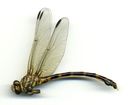Clubtails
Gomphidae
Classification
- Phylum: Arthropoda
- Subphylum: Hexapoda
- Class: Insecta
- Order: Odonata
- Suborder: Anisoptera
- Family: Gomphidae
Pronunciation
How to pronounce Gomphidae: /ɡɒmˈfaɪdiː/
These audio files are automatically generated. While they are not always 100% accurate, they are a good starting point.
Images






Summary
The Gomphidae family, commonly known as clubtails or club-tailed dragonflies, comprises about 900 species across numerous genera. They are characterized by their distinctive abdominal forms and wide distribution across various continents, often found near water bodies where they both breed and hunt for prey.
Physical Characteristics
Medium to large dragonflies, typically 40mm to 70mm in body length. Small, widely separated compound eyes that are blue, turquoise, or green. Thorax is pale with dark stripes that often serve as diagnostic features. Most species exhibit cryptic coloration; differences between sexes are minimal. Some individuals present an inflated club shape at the tip of the abdomen, especially in males.
Identification Tips
Identification can be made through a combination of color patterns and the morphology of male tail appendages, male secondary genitalia, and female genitalia plates. Close-up photographs are valuable, especially from above and the side.
Habitat
Clubtails breed in streams, rivers, or lakes. They commonly inhabit areas near water bodies.
Distribution
Approximately 900 species found worldwide, with significant populations in North and South America, Europe, Asia, Australia, and Africa.
Diet
Clubtails primarily prey on flying insects.
Life Cycle
Nymphs have a flat mentum and burrow in sediments at the bottom of water bodies, differing from many dragonfly larvae that prefer vertical surfaces. Some larvae emerge during the day, contrasting with the common nighttime emergence.
Reproduction
Breeding typically occurs in water bodies such as streams, rivers, and lakes. The specifics of their reproductive behaviors vary among species.
Ecosystem Role
As predators of flying insects, clubtails play a role in controlling insect populations.
Evolution
Gomphidae is the only family in the superfamily Gomphoidea and has undergone significant diversification, leading to a wide range of species.
Similar Taxa
Misconceptions
Some believe that the club shape at the abdomen's end is present in all species; however, it is variable and less pronounced in females and absent in some species.
Tags
- dragonflies
- Gomphidae
- clubtails
- odonata
- insecta